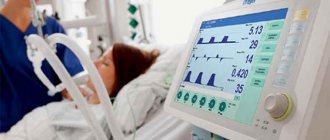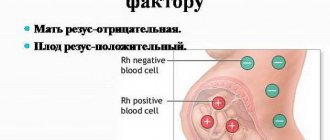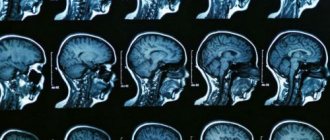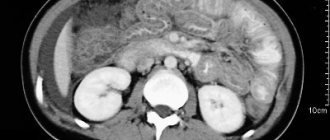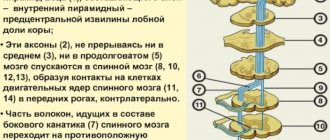Oxygen starvation ( hypoxia ) is a pathological condition that occurs as a result of insufficient oxygen content in the tissues of the body, namely when the partial pressure of oxygen in the inhaled gaseous environment drops below 0.016 MPa (0.16 kgf/cm2 or 16% in terms of atmospheric pressure)
The human body is accustomed to functioning at a certain partial pressure of oxygen. As we have seen, at normal pressure and breathing clean air it is equal to:
PO2=1*20/100=0.2 kgf/cm2
With such a supply of oxygen, the human body feels great and is very active.
Article navigation
Causes of oxygen starvation
Signs of oxygen starvation
First aid for oxygen starvation
How to avoid oxygen starvation
As the partial pressure of oxygen in the inhaled gas mixture drops to 0.16 kgf/cm2 and below, the oxygen saturation of the blood decreases. This leads to a decrease in the partial pressure of oxygen in the blood, as a result of which the supply of oxygen to the body cells is disrupted. The cells of the central nervous system and heart, especially the cerebral cortex.
Due to insufficient oxygen supply to the body's cells, a painful condition occurs called oxygen starvation (hypoxia).
Cells of the cerebral cortex tolerate hypoxia for a very short time. At a body temperature of 36–37°C, only 5-6 minutes, after which irreversible changes occur in the cells.
This period determines the duration of possible salvation of a person in diseases accompanied by oxygen starvation of the brain (hypoxia) (drowning and other types of suffocation, acute blood loss, etc.)
Scientists have proven that general cooling of the body makes it possible to extend this period to 1 hour.
Few diseases can quickly cause such profound and often irreversible changes in the body, with such minor manifestations in the victim’s well-being as oxygen starvation of the brain (hypoxia). Divers most often, during oxygen starvation, experience a sudden loss of consciousness without any prior noticeable phenomena by the diver himself .
The human body is very poorly adapted to tolerate rapidly developing acute oxygen starvation. There is a slight increase in cardiac activity and respiration.
People who are well trained for endurance endure oxygen starvation (hypoxia) more easily: their tissues use the oxygen available in the body more fully.
In diving practice, oxygen starvation of the brain occurs almost exclusively when working in equipment with a closed breathing pattern. This is because when breathing from a small volume, the partial pressure of oxygen quickly decreases and nitrogen accumulates in the respiratory mixture at the slightest omission in the operation of this equipment. Therefore, for divers It is important to know the signs of oxygen starvation.
Development mechanism
If we talk about pathogenetic variants of the disorder, there are more than 5 of them.
Let's look at them in more detail:
Hypoxic
It occurs especially often, but does not pose a great danger. At least for an ordinary, healthy person. We are talking about a simple lack of oxygen in the inhaled air.
Everyone has probably encountered this condition. In a stuffy room or during extreme heat. The head begins to hurt and feel dizzy. Nausea and weakness occur. Unexplained drowsiness appears.
All these are signs of hypoxia, a pathological process when the brain does not receive enough nutrients and oxygen. The condition is easy to correct. It is worth providing the body with the necessary gas.
To do this, just go outside or ventilate the room.
Respiratory
Much more dangerous in terms of development, course and probable consequences. Formed in response to respiratory diseases. This includes all pathologies of the respiratory tract.
The reason is simple - the lungs cannot provide a sufficient flow of oxygen. Consequently, there is nothing left to transport.
Brain cells starve, lacking the necessary substances.
Circulatory
Characterized by changes in cardiac structures. We are mainly talking about heart defects. Congenital or acquired.
The latter can develop against the background of a myocardial infarction, an inflammatory process, during an unsuccessful operation and other factors.
Be that as it may, the violation is significant and clearly visible. Blood simply does not have time to circulate at a sufficient speed and in the required volumes. This is the main problem.
The brain does not receive the amount of nutrients and oxygen it needs right away. Recovery is urgent and is carried out under the supervision of a cardiologist.
Toxic
As a result of acute or chronic poisoning. Intoxication can be of any kind. Usually we are talking about a reagent that inhibits cellular respiration.
These include many poisons of natural origin (those produced by the glands of snakes and insects).
Poisoning with certain medications also manifests itself in a similar way. Especially in high dosages. This also includes drugs.
Hematological
When the condition and composition of the blood changes. This happens, for example, when a person has been suffering from anemia for a long time.
The more advanced the pathological process, the lower the oxygen concentration in the red blood cells. For mechanical or other reasons.
Coping with this condition is quite difficult. Especially at pronounced, long-current stages of the pathological process.
Fabric
The result of disruption of cellular respiration and reverse excretion of carbon dioxide molecules. Occurs as a result of exposure to certain poisons. For example, cyanide compounds are particularly dangerous. Including gaseous ones.
They literally block oxygen exchange. Some diseases carry the same danger.
Reloading
Temporary phenomenon. If a person engages in physical activity, he uses a lot of oxygen. Blood circulation in the brain is temporarily weakened.
This is an adaptive mechanism. All resources are transferred to muscles and heart. This condition does not require treatment. It's quite normal.
So there are many mechanisms. They can be specified for a number of reasons. It is necessary to study etiological factors in order to quickly diagnose, identify a specific problem and eliminate it.
Signs of chronic hypoxia
In this position, a person experiences the following disorders:
- Headache. Intense and very painful for the patient. By nature it is bursting, pressing or shooting. Localized in various parts of the skull.
Most often, it is located in the area of the crown, temples and forehead. In the morning it can become even stronger. This is a clear sign of insufficient nutrition of cerebral structures.
After treatment, the clinical manifestation disappears.
- Dizziness. Oxygen starvation of the brain spreads to all its structures, when the extrapyramidal system and the cerebellum suffer, the person becomes hostage to constant dizziness.
It can lead to falls and injuries as a result of poor orientation in space.
Attention:
It makes no sense to correct a symptom in isolation. The underlying cause must be treated. Then the sign will disappear by itself.
- Memory loss. Gradual, but clearly noticeable both for the person and for his environment. Sudden lapses occur and it becomes difficult to remember a phone number or information that has just been perceived.
This is the initial phase. Then long-term memory suffers. The person cannot remember significant events. The process is not instantaneous, but it is very aggressive and seriously interferes with life.
- Decline in the speed and quality of thinking. Typical early symptoms of brain hypoxia are cognitive impairment, that is, a decrease in intelligence, ability to concentrate, and learning.
This seriously affects the patient’s professional activity. Often, at advanced stages of the pathological process, he is no longer able to perform work duties and is forced to leave work.
It makes sense to start treatment before the process becomes irreversible.
- Tinnitus is the main manifestation of cerebral hypoxia. Develops from the very first for a pathological condition. The noise in the head can be anything: buzzing, squeaking, hissing. It depends on the individual perception of the patient.
The condition always accompanies a person, both at night and in the morning. Both in a noisy visit and in complete silence. The clinical manifestation causes a lot of psychological discomfort.
- Nausea. A characteristic sign of oxygen starvation of the brain is a critical increase in hypoxia in the morning, when a person just gets up, as a feeling of nausea and the urge to vomit develops. This is the result of blood stagnation in the early part of the day.
Gradually, as vascular tone increases, the arteries begin to work, everything returns to relative normality. It gets worse towards the end of the day. After a busy day at work.
- Vomiting. Doesn't always happen, but often. An episode of nausea culminates. In this case, it does not matter at all whether a person took food or not.
- Sleep disorders. A sign that the brain is not getting enough oxygen is an inability to rest at night. The patient often wakes up or cannot fall asleep at all for several hours. Toxins that accumulate in cerebral structures, poison nerve tissue, make the situation even worse.
- Speech disorders. Problems with both the formal construction of statements, articulation, and the logical component, the meaning of expressions. All this is the result of hypoxia of the temporal and frontal lobes.
- Problems with coordination. The patient tries to fall out of the blue and cannot walk in a straight line. Constantly deviates, as if he drank too much.
- Possible loss of consciousness. Regular fainting is a clear sign of insufficient oxygen supply to the brain. Chronic hypoxia is accompanied by increased symptoms, headaches, nausea, vomiting, and focal disorders as the disease itself worsens.
And this happens quite quickly: in a matter of years.
- Fatigue. Increased fatigue. Work becomes difficult. The previous loads are already difficult to bear. And then it’s completely impossible. Hypoxia seriously affects social activity and life in society.
- Behavioral and emotional disorders. Aggression, irritability, tearfulness and other conditions. A “swing” is possible: sometimes euphoria, sometimes depression. Moreover, there is a tendency towards the second extreme.
Symptoms of cerebral hypoxia are neurological manifestations, focal and general, such as headache, nausea, vomiting, speech disorders, coordination and others.
You need to fight them, as well as the underlying disease that brings a person to a critical point.
Signs of the acute stage
The clinical picture is rapidly evolving, and dangerous manifestations arise:
- Severe, unbearable headache. It develops literally in a few minutes, as they say, out of the blue. The exact location cannot be determined. The sensation seems to spread throughout the entire skull.
- A feeling of unreality of what is happening. The symptom heralds the beginning of changes in cerebral structures. A person already finds it difficult to navigate in space. And then - in one’s own personality. Gradually consciousness goes away, the normal state is lost.
- Floaters before the eyes. Shiny white or colorful dots that fly into the field of view. This is the result of overstimulation of the occipital lobe of the brain.
This is how cerebral structures try to convulsively start themselves up and start working with renewed vigor. But nothing works. These simple visual hallucinations subside quite quickly.
- Feeling of distance from sound stimuli. Everything seems distant. Even if the person who is shouting to the victim is standing a meter away from him.
- Loss of consciousness. Critical point in the development of the pathological process. This ends acute hypoxia.
- Shortness of breath, nausea.
Lack of oxygen in the brain is accompanied by neurological deficits, disturbances in the functioning of cerebral structures in general and at the level of individual formations and lobes. There is not much time to help.
The patient himself experiences symptoms for a short period of time. Less than a minute passes from the moment the first signs appear until loss of consciousness. After a few more seconds, coma sets in.
From this moment on, doctors have no more than 5-6 minutes to return the patient to normal without consequences. The longer the brain is without oxygen, the higher the likelihood of turning into a “vegetable” or dying.
First aid for oxygen starvation
- lift a diver out of the water using the signal end quickly, but not with sudden jerks, so that the diver does not also suffer from barotrauma of the lungs.
- If the diver is confused and it is impossible to lift him by the signal end, it is necessary to immediately lower the safety diver. Approaching the victim, he must ensure that the latter is included in the apparatus, check the degree of filling of the breathing bag of his apparatus and, if necessary add oxygen to the bag , controlling the filling bag by hand.
- After rising to the surface, immediately remove the equipment and find out whether the diver is breathing or not. The mouthpiece is often jammed, and to remove it requires unclenching the jaws using a mouth opener. In case of disorder or cessation of breathing and absence of cardiac activity, mechanical ventilation and indirect cardiac massage are performed (how this is done written HERE). If you have a pressure chamber, these measures are carried out simultaneously with the use of the therapeutic recompression mode. This is very important to do, because if the diver is not breathing, the only thing that can save him is immediate effective artificial respiration.
- If the victim continues to breathe naturally, in most cases it is enough to switch him to breathing with atmospheric air, oxygen or DGS. Oxygen barotherapy has a good effect. The awakened diver is not allowed to walk or get up on his own for 2 hours, so as not to sharply worsen his condition.
Causes
The issue has already been partially addressed in the “mechanisms” of hypoxia development. Now it’s worth saying in more detail about the most common provoking factors:
- Inflammatory processes in the brain. Encephalitis and meningitis are the most common variants of the disorder.
They are relatively rare, but pose a huge danger. They destroy tissues of cerebral structures. The second damaging factor is insufficient blood circulation.
In the system, both of these moments provoke disorders of higher nervous activity, persistent deviations that are almost impossible to treat.
- Diseases of the respiratory system. Asthma, pneumonia, lesions of the trachea, larynx, and other structures. A huge layer of infectious and other problems. Urgent medical attention is required. Otherwise, you may encounter acute hypoxia.
- Cardiovascular pathologies. Arterial hypertension, heart defects, disorders of the structure of the blood vessels themselves. They are treated under the supervision of cardiologists and specialized surgeons, if there is a reason for this. The task is not easy. Many conditions are difficult to correct.
- Poisoning with salts of heavy metals and vapors of volatile substances. Intoxication. Cause acute conditions. Time for therapy is minimal.
- Anemia of various forms. Hemolytic, iron deficiency, megaloblastic and others. They cause approximately the same thing: lack of hemoglobin, inability to transport oxygen.
- Natural factors in the development of the pathological process. Excessive physical activity, deficiency of O2 in the air and other issues. They do not pose a great danger and can be easily corrected even on their own.
- Atherosclerosis of cerebral vessels. Blockage of blood vessels with cholesterol plaques. They can provoke a stroke, as a type of acute cerebral hypoxia. The larger the affected area, the worse the situation overall.
The reasons are determined in order to prescribe competent treatment.
Perspective
Hypoxic-anoxic brain damage is very serious and can lead to severe and irreversible damage.
Being aware of the symptoms of hypoxia and anoxia and seeking immediate medical attention is critical. A quick medical response can help reduce complications and determine the speed and success of recovery.
Although some people make a full recovery, there are many treatment options for those who need support after a traumatic brain injury to help them rehabilitate, including physical, mental and occupational therapy.
Diagnostics
The examination is carried out under the supervision of a neurologist. In the chronic form of the pathological process, there is some time for action.
Among the procedures:
- Oral questioning of the patient to identify symptoms and create a complete clinical picture.
- Anamnesis collection. For the sake of understanding what caused the pathological condition.
- General blood analysis. They study the concentration of red blood cells, which are responsible for carrying oxygen.
- Biochemistry with an expanded indicator for lipids. As part of the diagnosis of atherosclerosis.
- Encephalography (REG). Used to study brain activity. Indirectly, all deviations indicate possible problems with nutrition and cellular respiration.
- ECG and ECHO-Kg. As part of the examination of the heart and blood vessels.
- MRI if necessary.
- Blood pressure measurement.
- Routine neurological examination.
Lack of oxygen in the brain is detected by the results of more specific measures: angiography, rheovasography, capnography. Those techniques that study the concentration of oxygen in the body, the speed of blood flow, and its quality.
If we are talking about acute hypoxia, there is not much time for diagnosis. A basic neurological examination is performed. Then, depending on the situation, they begin to act.
Diagnostic examination
The purpose of the examination for hypoxia is to identify the root cause of the pathology. Diagnostic search includes:
- Blood monitoring (general and gas analysis).
- Encephalogram - identification of damaged areas of the brain.
- Rheovasography , which allows you to assess the condition of the vessels supplying the brain.
- Angiography (general and selective) - for a more complete display of the blood flow picture.
- MRI – to identify possible areas of ischemia in the brain structure.
- CO-metry and capnography , allowing to identify possible functional disorders in the lungs.
Treatment
During therapy, you need to focus on the mechanism of development of the pathological process. It is worth considering the issue in more detail:
- Hypoxic form. Oxygen inhalations are prescribed. The point is to compensate for the lack of the required amount of gas. Often, you manage to cope with the situation on your own. All you have to do is open a window or go outside.
- Respiratory form. Treatment of the underlying pathological process is carried out. Antibiotics, anti-inflammatory drugs, hormones, inhaled bronchodilators and other methods are used.
- Circulatory variety. Treatment of heart disease is necessary. Surgical correction of the defect, plastic surgery or prosthetics are performed. Cardioprotectors are prescribed: Mildronate, Riboxin. Antihypertensive drugs if high blood pressure occurs.
- Toxic type. Carry out a complete cleansing of the body. Specialized antidotes are infused.
- Hematological. Use large doses of iron and vitamins. Other remedies to eliminate insufficient blood circulation.
- Fabric. The same antidotes are prescribed. Cleanse the body.
- Reloading. It’s worth some time to rest and get back to normal.
As for general therapy, nootropics are prescribed to speed up metabolic processes in the brain. For example, Glycine or more powerful analogues like Phenibut.
Cerebrovascular restores normal blood circulation in cerebral tissues. Piracetam, Actovegini others.
Atherosclerosis is treated with statins, fibrates and nicotinic acid. Plus a diet is prescribed. If the cholesterol plaque is old and already covered with calcium salts, an operation is prescribed to remove it mechanically. Tablets are powerless here.
Consequences
There can be many complications of brain tissue hypoxia.
Among them:
- Dementia.
- Focal neurological disorders. Which ones exactly depend on the localization. Frontal lobe - the emotional sphere, behavior, and intelligence suffer. Temporal - hearing, the psyche in general. Occipital - motor activity, vision, and so on.
- Hallucinations, delusions.
- “Vegetable condition”, severe disability.
- Death as a result of the pathological process.
Brain hypoxia occurs in most patients with hypertension, metabolic disorders and hundreds of other diseases. To compensate for the condition, you need to undergo full treatment. This is also a measure to prevent dangerous complications.
diagnosing
If a person exhibits symptoms of anoxia, a doctor will likely perform several tests to try to determine the cause and make an accurate diagnosis.
These tests include
- blood tests
- magnetic resonance imaging (MRI).
- functional magnetic resonance imaging (fMRI) scan
- computed tomography (CT) to obtain images of the brain.
- electroencephalogram (EEG) to test the electrical activity of a person's brain.

